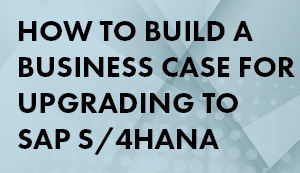The Move to Cloud is Crucial Now: Bimal Soni
Meet the Authors
Key Takeaways
Organizations increasingly view cloud deployments as crucial for digital transformation, driven by factors like scalability, cost reductions, and the need for modernized business processes.
The move to cloud ERP systems like SAP S/4HANA is essential before SAP's support deadlines for legacy systems, as starting early can mitigate costs and reduce risks associated with unsupported systems.
Transitioning to cloud infrastructure not only lowers operational costs but also provides significant advantages in cybersecurity, data management, and access to real-time analytics, enhancing overall business competitiveness.
Recent research by SAPinsider shows that an increasing number of organizations view cloud-based deployments as the biggest factor driving their business’s focus on digital transformation.
In the first of a two-part interview with SAPinsider, Bimal Soni, Senior Vice President, Enterprise Applications of Resolve Tech Solutions, highlights why now is the best time for organizations to embark on their digital transformation journey.
“For most customers, implementing or transforming an ERP system is a capital-intensive event they can afford once in 10-15 years,” Soni says, explaining the need to modernize ERP systems now. “So, when there is so much change on the software platform level, it becomes difficult for organizations and its leaders to figure out the right path to achieve their business objective while ensuring daily business continuity.”
Explore related questions
Today, technology has matured for cloud infrastructure and other capabilities covered under SAP S/4HANA and the SAP Cloud Suite. Apart from this, Soni believes three factors are driving ERP modernization for customers:
- Cloud adoption: Businesses are increasingly compelled to move to the cloud for multiple reasons, such as scalability, cost reductions, and availability.
- New business models: Over the last decade or so, many industries have witnessed significant disruption in their business models or have grown through acquisitions or geographical expansion. All these factors have led them to revisit their current business processes to modernize and improve productivity and efficiency. Many of these modern processes are now available on the new SAP S/4HANA ERP platform.
- Data-driven approach: Real-time data and analytics are gaining importance for businesses to make quick decisions and adapt to market conditions. ERP systems like SAP S/4HANA provide that aspect.
Still, organizations worry about the initial cost of implementation or migrating to cloud ERP like SAP S/4HANA.
Saving costs
However, Soni says that moving infrastructure to the cloud platform is one of the simplest ways to ease that cost pressure as “it reduces the cost of operating infrastructure significantly.” He adds that cloud ERP technology has come a long way in terms of reducing downtime and providing better cybersecurity. Also, by using cloud ERP like SAP S/4HANA, companies save on the time and costs of operating the ERP Platform in-house.
“So, the long-term benefits and cost-effectiveness of moving to the cloud far outweigh the initial cost of this move,” he explains.
Moreover, SAP S/4HANA’s simplified data model eliminates redundant tables, resulting in fewer tables and a reduced data footprint. Utilizing in-memory storage and a columnar database design, transactional data can achieve compression ratios of up to 5:1, significantly lowering storage requirements. As a result, companies leveraging SAP S/4HANA can maintain a smaller infrastructure than traditional ERP systems, yielding substantial cost savings on hardware.
A crucial time
“The move to cloud [for organizations] is crucial now,” says Soni, referring to two vital dates set by SAP. The first is December 20, 2027, when SAP will stop its mainstream support for ERP platforms like SAP ECC. After December 2027, SAP is expected to charge a 2-4% premium to support ECC customers who have migrated to the cloud but have kept their legacy system operational. The second date is December 2030, when SAP will cease supporting the ECC platform completely.
“According to research, there are over 100,000 ECC customers in North America alone and around 65% of these are yet to migrate to the cloud or acquire an S/4HANA license,” he says.
Soni elaborates: “With thousands of customers yet to start the journey, the cost of moving to S/4HANA could increase due to a shortage of skilled professionals, a surge in last-minute demand, inflationary pressures, and the complexity of the ERP transformation projects. Starting the S/4HANA transformation sooner rather than later can help mitigate these costs by selecting a more flexible, phased approach according to the organization’s needs.”
These customers can incur higher support costs by running unsupported systems. The lack of updates for unsupported systems can also result in security and compliance risks. Additionally, an older version of ERP limits the organization’s ability to implement the latest innovations in the areas of user experience, real-time data and analytics, artificial intelligence and machine learning, to automate processes. This could hurt the organization’s overall competitiveness.
In the final part of this interview, Soni gives insights into how organizations can embark on their digital transformation journey and why implementation partnerships matter.






